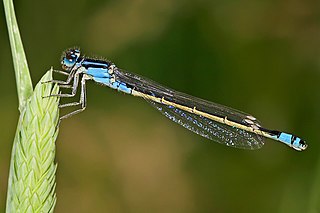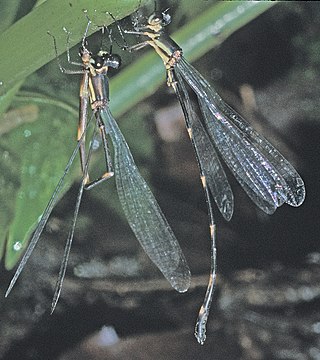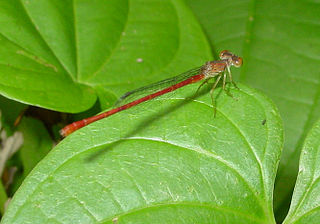
Coenagrionidae or are a family of damselflies, also known as pond damselfies, in the order Odonata and the suborder Zygoptera. The Zygoptera are the damselflies, which although less known than the dragonflies, are no less common. More than 1,300 species are in this family, making it the largest damselfly family. The family Coenagrionidae has six subfamilies: Agriocnemidinae, Argiinae, Coenagrioninae, Ischnurinae, Leptobasinae, and Pseudagrioninae.

Argia is a genus of damselflies of the family Coenagrionidae and of the subfamily Argiinae. It is a diverse genus which contains about 114 species and many more to be described. It is also the largest genus in Argiinae. They are found in the Western Hemisphere. They are commonly known as dancers. Although the genus name comes from Ancient Greek: ἀργία, romanized: argia, lit. 'laziness', dancers are quite active and alert damselflies. The bluer Argia species may be confused with Enallagma species.
Mnesarete is a genus of damselflies in the family Calopterygidae.

Sympetrum is a genus of small to medium-sized skimmer dragonflies, known as darters in the UK and as meadowhawks in North America. The more than 50 species predominantly live in the temperate zone of the Northern Hemisphere; 15 species are native to North America. No Sympetrum species is native to Australia.

Enallagma is a genus of damselflies in the family Coenagrionidae commonly known as bluets. Bluets can be distinguished from the similar vivid dancer by wing position; at rest, bluets' wings hang down on either side of their body, while vivid dancers hold their wings above their body. Bluets also have shorter leg spines.

Erpetogomphus is a genus of dragonfly in the family Gomphidae. They are commonly known as ringtails. Most of the species are predominantly green coloured and the males have a moderately clubbed tail. A fossil species are known from the Miocene Mexican amber

Heteragrion is a genus of damselflies in the family Heteragrionidae.

Ischnura is a genus of damselflies known as forktails in the family Coenagrionidae. Forktails are distributed worldwide, including various oceanic islands. The males have a forked projection at the tip of the abdomen which gives the group their common name.

Neoneura is a genus of damselfly in the threadtail family Coenagrionidae. They are found in the Neotropics, from Cuba and Texas to Argentina.

Ophiogomphus, commonly known as snaketails, is a genus of dragonflies in the family Gomphidae. Most of the species in the genus Ophiogomphus have beautifully marked green club-shaped abdomens, which are more noticeable in the males.

Palaemnema is a genus of dragonflies in the family Platystictidae. They are commonly known as shadowdamsels and are found in the New World, from Arizona to Peru and French Guiana.

Progomphus is a genus of medium-sized dragonflies in the family Gomphidae. They are found in the Americas and are largely tropical. They are one of the few Gomphids with coloured wings.

The Protoneuridae are a family of damselflies. Most species are commonly known as threadtails, while others are commonly known as bambootails.

Brechmorhoga is a genus of dragonfly in the Libellulidae family. Members of this genus are commonly called clubskimmers because of the widening abdominal segments much like the clubtails.

Nehalennia is a genus of very small damselflies in the family Coenagrionidae. Most of the species are commonly known as Sprites. One species, N. speciosa occurs in Eurasia; the rest in North and South America.

Telebasis is a genus of damselflies in the family Coenagrionidae. The genus occurs in the Neotropics. Most of the species are red with a few blue species in South America.

Micrathyria is a Neotropical genus of dragonflies. They have bright green eyes and white faces. Most species have a markedly striped thorax. They are commonly known as Tropical Dashers.

Triacanthagyna is a genus of dragonflies in the family Aeshnidae. The species have large eyes and broad wings. The females have three prominent spines under the last abdominal segment which gives the genus its name. They are commonly known as three-spined darners.

Macrothemis is a genus of dragonfly in the family Libellulidae, also known as Sylphs. It contains the following species:

Acanthagrion quadratum, or Mexican wedgetail, is a pond damselfly of the family Coenagrionidae. It was first described by Edmond de Sélys Longchamps in 1876.



















